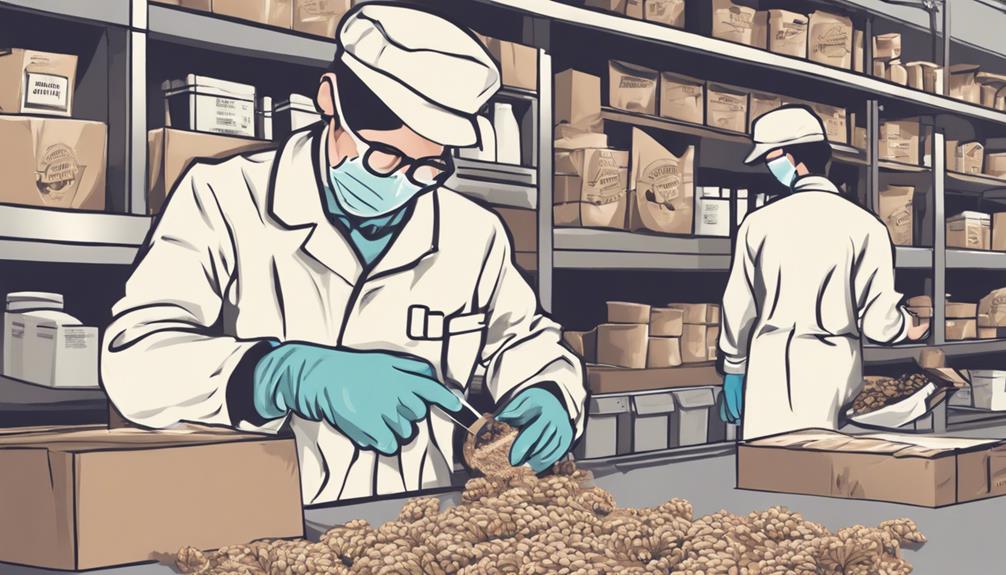Key Precautions for Safer Natural Food Packaging
You might not realize it, but the packaging of natural foods can impact their safety more than you think. From the material chosen to how it's sealed, several key precautions can make a difference in keeping your food fresh and free from contaminants.
By following these guidelines, you can ensure that the natural goodness of your food remains intact.
But there's one crucial aspect that you might be overlooking, and it could make all the difference in the world.
Proper Material Selection
When choosing materials for natural food packaging, prioritize durability over aesthetics to ensure product safety and freshness. Opt for eco-friendly alternatives and biodegradable options to reduce environmental impact while maintaining the quality of the packaged food.
Eco-friendly alternatives like compostable cornstarch-based plastics or biodegradable sugarcane bagasse containers provide sustainable packaging solutions that minimize waste and pollution.
Biodegradable options, such as packaging made from plant-based materials like PLA (polylactic acid) or recycled paper, help in reducing the carbon footprint of the packaging process. These materials break down naturally over time, reducing the amount of plastic waste that ends up in landfills and oceans. By choosing biodegradable options, you contribute to a healthier planet while ensuring the safety of the food products you package.
It is essential to consider the end-of-life disposal of the packaging materials when selecting them. Opt for materials that can be easily recycled or composted to further minimize environmental impact. By prioritizing durability and eco-friendliness in your material selection, you not only ensure the safety and freshness of the packaged food but also contribute to a more sustainable and environmentally conscious approach to natural food packaging.
Avoiding Contaminants
To ensure the safety and quality of natural food packaging, it's crucial to implement strict measures to avoid contaminants. Proper cleaning procedures are essential in preventing the presence of harmful substances in natural food packaging. Thoroughly cleaning all equipment, surfaces, and tools that come in contact with the packaging materials helps eliminate potential contaminants that could compromise the integrity of the product. Regular sanitation routines should be established and strictly followed to maintain a hygienic environment during the packaging process.
In addition to cleaning procedures, the design of the packaging itself plays a significant role in preventing contaminants from affecting the natural food products. Selecting packaging materials that are resistant to moisture, pests, and other external factors can help safeguard the contents from contamination. Furthermore, choosing packaging designs that minimize the risk of exposure to air, dust, or other pollutants is crucial in maintaining the freshness and quality of the natural food items.
Ensuring Airtight Sealing
To maintain the integrity and freshness of natural food products, achieving an airtight seal on the packaging is essential. An airtight seal helps prevent oxygen and moisture from entering the packaging, which can lead to spoilage and contamination of the food products.
Here are some key points to consider when ensuring airtight sealing:
- Extending Shelf Life: An airtight seal helps prolong the shelf life of natural food products by minimizing exposure to air and moisture, which can cause food to spoil faster.
- Preventing Bacteria Growth: By sealing the packaging airtight, you create an environment that inhibits the growth of bacteria, helping to maintain the safety and quality of the food.
- Preserving Freshness: Airtight sealing locks in the freshness of natural food products, preserving their taste, texture, and nutritional value for a longer period.
- Enhancing Food Safety: Properly sealed packaging reduces the risk of contamination and cross-contamination, ensuring that the food remains safe for consumption.
- Maintaining Quality: An airtight seal protects the natural food products from external factors that could compromise their quality, such as odors, moisture, and pests.
Monitoring Temperature Conditions
Monitoring the temperature conditions regularly is crucial for ensuring the freshness and quality of natural food products. Temperature control is a vital aspect of food packaging, as it directly impacts the product's shelf life and safety. It's essential to maintain the recommended temperature range during storage and transportation to prevent bacterial growth and food spoilage.
Proper temperature control helps preserve the nutritional value of natural food products and minimizes the risk of contamination. Fluctuations in temperature can compromise the integrity of the packaging, leading to leaks or breakages that expose the food to external elements. By monitoring temperature conditions, you can ensure that the packaging remains intact and effectively protects the contents from physical damage and contamination.
Packaging integrity is closely linked to temperature management, as extreme temperatures can cause materials to expand or contract, affecting the sealing properties of the packaging. Regularly checking the temperature levels in storage facilities, refrigerated trucks, and retail outlets is essential to identify any deviations from the optimal range. Implementing temperature monitoring systems and using temperature-sensitive labels can help you track and record temperature variations throughout the supply chain.
Preventing Cross-Contamination
Implementing stringent hygiene practices is essential in preventing cross-contamination in natural food packaging. Cross contamination prevention is crucial to ensure the safety and quality of the food products.
Here are some key steps to help you prevent cross-contamination effectively:
- Separate Work Areas: Designate specific areas for handling raw foods and ready-to-eat items to avoid any potential contact between the two.
- Use Color-Coded Tools: Utilize color-coded cutting boards, knives, and utensils to differentiate items used for raw foods from those used for cooked foods.
- Frequent Hand Washing: Encourage regular hand washing among staff members to maintain cleanliness and reduce the risk of contamination.
- Clean and Sanitize Surfaces: Regularly clean and sanitize all surfaces, equipment, and utensils that come in contact with food to prevent the spread of harmful bacteria.
- Proper Storage: Store raw ingredients away from ready-to-eat foods and ensure proper labeling and organization in storage areas to minimize the risk of cross-contamination.
Checking for Leakages
To ensure overall safety and integrity of natural food packaging, make sure to thoroughly check for leakages in packaging materials. Leak detection is crucial in preserving the quality and freshness of the food products contained within. When examining packaging, look for any signs of leaks such as dampness, discoloration, or strange odors that may indicate a breach in package integrity.
Inspect the packaging carefully by running your hands along the seams and edges to feel for any moisture or stickiness. Additionally, visually examine the packaging for any visible holes, tears, or punctures that could compromise its ability to contain the food properly. It's essential to address any leakages promptly to prevent contamination and spoilage of the natural food products.
Package integrity is paramount in ensuring that the contents remain safe for consumption. Even the smallest leak can lead to microbial growth, affecting the quality and safety of the food. By conducting regular checks for leakages, you can maintain the freshness of the natural food items and extend their shelf life.
Implementing Quality Control Measures

When ensuring the safety and quality of natural food packaging, prioritize the implementation of robust quality control measures. By establishing stringent quality control protocols, you can uphold the integrity of your products and safeguard consumer health.
Here are key steps to consider:
- Regular Quality Audits: Conduct frequent assessments of your packaging processes to identify any potential issues and address them promptly.
- Supplier Partnerships: Collaborate closely with your packaging material suppliers to ensure they meet strict quality standards and adhere to regulatory requirements.
- Consumer Feedback: Actively solicit and analyze feedback from consumers regarding the quality and safety of your packaging to make necessary improvements.
- Training Programs: Provide comprehensive training to your staff involved in packaging processes to ensure they understand and follow best practices.
- Documented Procedures: Maintain detailed documentation of your quality control measures and update them regularly to reflect any changes or improvements.
Storing in Suitable Environments
Prioritize storing natural food packaging in suitable environments to maintain product integrity and ensure consumer safety. Proper humidity control is essential for extending the shelf life of natural food packaging. High humidity can lead to moisture buildup, causing packaging materials to degrade and potentially contaminating the food products. Conversely, low humidity levels can result in the drying out of packaging materials, leading to brittleness and decreased effectiveness in protecting the food items. Therefore, it's crucial to store natural food packaging in environments where humidity levels are regulated to optimal conditions.
Temperature management is another critical factor in ensuring food safety when storing natural food packaging. Fluctuations in temperature can accelerate the degradation of packaging materials, compromising their ability to protect the food products inside. Extreme temperatures can also lead to the growth of harmful bacteria or mold, posing serious health risks to consumers. To prevent these issues, store natural food packaging in areas with controlled temperatures to maintain the quality and safety of the packaged products.
Frequently Asked Questions
How Do Natural Food Packaging Materials Impact the Shelf Life of the Product?
Natural food packaging materials can impact the shelf life of the product by influencing freshness. Opting for eco-friendly options like paper, cardboard, or bioplastics can help maintain freshness longer. These materials often have breathable properties that allow the food to stay fresher for a more extended period.
Are There Any Specific Regulations or Certifications to Look for When Selecting Natural Food Packaging Materials?
When choosing natural food packaging materials, look for certification requirements and safety standards to ensure quality and safety. Consider the environmental impact and prioritize biodegradability for sustainable packaging choices.
Check for certifications like USDA Organic, BPI, or FSC to guarantee environmental responsibility. Be vigilant about meeting safety standards to protect consumers and the environment while selecting packaging materials that align with your values and sustainability goals.
Can Natural Food Packaging Materials Be Reused or Recycled?
When choosing natural food packaging, make sure to consider reusability and recyclability. Opt for materials that can be easily reused or recycled to reduce environmental impact and promote sustainability.
Look for packaging that can be repurposed or disposed of responsibly. By prioritizing reusability and recyclability, you can make a positive impact on the environment and contribute to a more sustainable food packaging system.
What Are the Potential Risks of Not Properly Monitoring Temperature Conditions in Natural Food Packaging?
When you neglect to monitor temperature conditions in natural food packaging, you face risks like bacterial growth due to temperature deviations. Without proper oversight, harmful bacteria can multiply rapidly, leading to food spoilage and potential health hazards for consumers.
Monitoring risks associated with temperature fluctuations is crucial to ensure the safety and quality of the packaged natural foods. Stay vigilant to prevent these issues and maintain the integrity of your products.
How Can Consumers Ensure They Are Purchasing Natural Food Products That Have Been Packaged Safely and Securely?
To ensure you're buying safe natural food products, educate yourself on proper packaging safety measures. Check for seals, tamper-proof features, and expiration dates to verify product authenticity.
Be aware of contamination risks in packaging and opt for reputable brands with transparent labeling. Stay informed about food safety guidelines and storage recommendations to protect yourself from potential hazards.
Conclusion
So remember, when it comes to natural food packaging, always prioritize proper material selection, avoid contaminants, ensure airtight sealing, monitor temperature conditions, prevent cross-contamination, check for leakages, implement quality control measures, and store in suitable environments.
By taking these key precautions, you can help ensure the safety and quality of your natural food products for consumption. Stay vigilant and proactive in your packaging practices to protect both your products and your customers.
